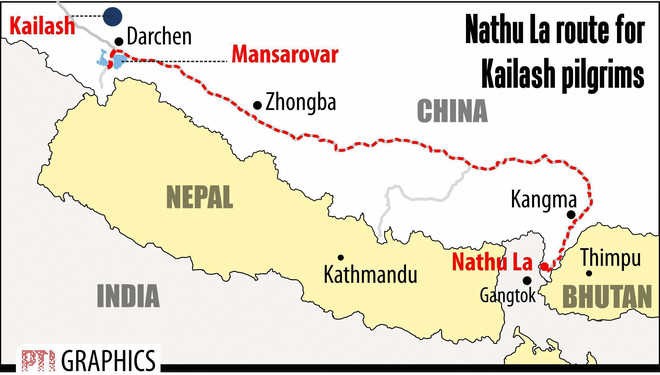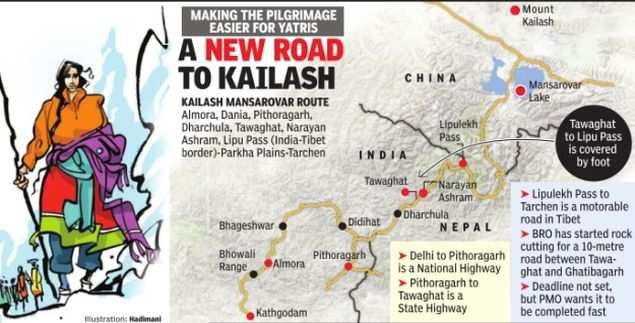Why in news?
Border Roads Organisation (BRO) has completed the road connectivity from Dharchula to Lipulekh (China Border) famously known as Kailash-Mansarovar Yatra Route.
Details:
- The Darchula – Lipulekh road is an extension of Pithoragarh-Tawaghat-Ghatiabagarh road.
- It originates from Ghatiabagarh and terminates at Lipulekh Pass, the gateway to Kailash Mansarovar. In this 80 Km road, the altitude rises from 6000 feet to 17,060 feet.
- With the completion of this project, the arduous trek through treacherous high-altitude terrain can now be avoided by the Pilgrims of Kailash MansarovarYatra and the period of journey will be reduced by many days.
- At present, the travel to Kailash Mansarovar takes around two to three weeks through Sikkim or Nepal routes. Lipulekh route had a trek of 90 Km through high altitude terrain and the elderly yartris faced lot of difficulties. Now, this yatra will get completed by vehicles.
Old route of Kailash MansarovarYatra:

New route of Kailash MansarovarYatra:

Background:
- Pilgrims from India can reach Kailash Mansarovar through three routes — via Sikkim, Uttarakhand and Kathmandu in Nepal — all of which are long and arduous.
- The route via Uttarakhand involves three stretches. The first stretch is a 107.6 km-long road from Pithoragarh to Tawaghat, the second is from Tawaghat to Ghatiabgarh on a 19.5-km single lane, and the third stretch is the 80 kms from Ghatiabgarh to Lipulekh Pass at the China border, which can only be traversed on foot. This stretch till the India-China pass takes five days to cover.
- The BRO is converting the second stretch into a double lane road, and is building a new road on the third stretch to allow vehicles. It has so far completed 76 km of the 80-km stretch, cutting travel time to just two days by a vehicle.
- On crossing the International Border into China, pilgrims must walk another 5 km, followed by a road journey of 97 km and the final 43 km-parikrama around Mount Kailash.

Travel to Kailash
- The Kailash-Mansarovar road alignment is along the Kali river, which is the boundary between India and Nepal.
- The end point of road is at Lipulekh Pass, a tri-junction of India, China and Nepal.
- The yatra is organised by the Ministry of External Affairs and the journey beyond the International Border is overseen by Chinese authorities.
Kailash-Mansarovar:
- Kailash Manasarovar, the Hindu holy site located in Tibet. Every year, the Indian pilgrims have a visit to this holy site.
- Kailash Manasarovar, a pilgrimage for the followers of four religions, is the toughest pilgrimage in the world.
- Situated some 20 km from the Mt Kailash, the lake Manasarovar further holds a prime significance in the mythology.
- This region sees an inception of four of the prime rivers namely Sutlej, Indus, Brahmaputra and Karnati.
- Kailash Mansarovar Yatra is known for its cultural significance, religious value, physical beauty and thrilling nature.
- Holding importance for the Hindus as the abode of Lord Shiva, it embraces religious importance also for the Buddhists and the Jains.
- The Kailash Manasarovar Yatra is arranged by the Government of India, Ministry of External Affairs beginning early May/early June to September.
About the Manasarovar lake
- It is located near the foot of the Mount Kailash and its waters are replenished by the Kailash Glaciers in the Tibet Autonomous Region, China.
- Lake Manasarovar lies at an elevation of 4590 m above the mean sea level. This is relatively unknown for a freshwater lake, though higher and larger saline water lakes exist in the Tibetan Plateau.
- The Kailash Mansarovar lake holds a highly revered sacred place in four religions (Bon, Buddhism, Hinduism, and Jainism) and is the site of an annual pilgrimage undertaken by Indian citizens known as the Kailash Mansarovar Yatra.
- The Mansarovar Lake, along with its nearby saline counterpart, the Rakshas-Tal lake were parts of the Sutlej Basin in the past but are now separated due to tectonic activity.




